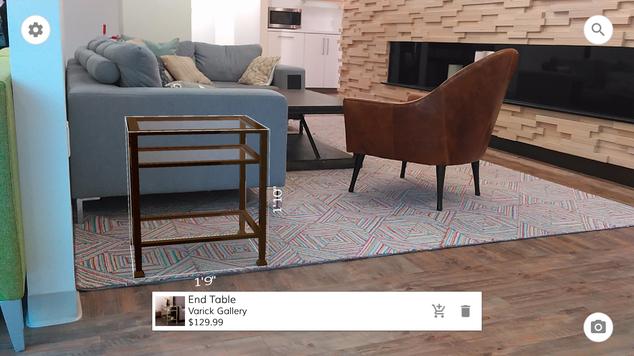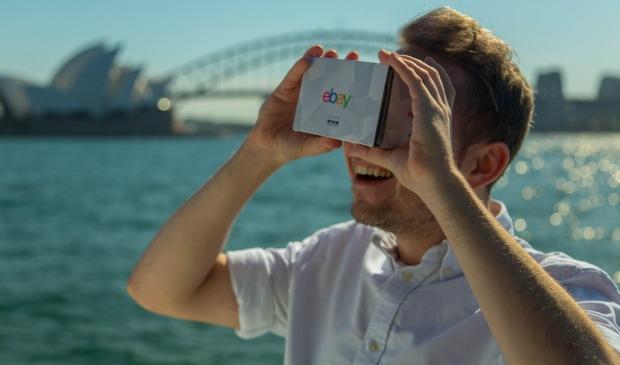
Scenes like this in stores such as Target are ‘vignettes’ which allow the customer to visualize how everything would look in their own homes. While still popular, virtual and augmented reality apps may make shopping even easier. [Photo: Target via AP]
While it sometimes feels like one of life’s more defining moments seeing that furniture truck finally pulling up to your curb, treasures for the living room and bedroom inside, it can also be one of the worst disappointments possible when nothing fits how you expected or just generally falls completely flat in terms of your original interior decorating vision. Most of us had had that experience and it turns into a ‘live and learn’ experience, often at great detriment to the wallet; and let’s face it, many people around the world are going through far worse life trauma than a bad furniture situation, but why not avoid this minor emotional distress if possible?
This is where new technology like virtual reality comes in very handy. And while it’s been on the horizon for the human race for decades via projections for the future, and glamorized in one sci-fi book and movie after another, we have not really seen assistance from the likes of VR or augmented reality coming to fruition until now, and especially on the heels of the very popular Oculus Rift system seen in the gaming realm. In a society where we expect everything now, now, now, it only seems normal really that we should be able to get a realistic preview of nearly everything—especially that new couch we hope to form a long and wonderful relationship with.
That’s precisely why companies like online home retailer Wayfair, headquartered in Boston, are not only working to make their catalog digital, but also to begin testing out both AR and VR apps such as WayfairView, along with 3D models of their products. According to Steve Conine, co-founder and co-chairman, this is in line with their mission to constantly raise the bar in terms of customer experience, creating “the best possible shopping experience for the home, adapted to how consumers shop today and in the future.”Even if you aren’t in the market for new furniture, the Wayfair app looks enticing. This type of convenience for customers isn’t just good for the new setup of the family room—it’s really good for business. Not looking just at furniture but also accessories, shoppers are able to see all of these items nearly in real life, and at full scale, all before plunking down that credit card. Even items like light fixtures and their placement can be examined—meaning those in the construction process have a lot of more resources to play with these days.
Wayfair will also be expanding in the area of AR in the near future, producing a related app for Google Tango, which is something we should all be hearing a great deal about, considering how multi-faceted it is as a tool. Set for release in September, Wayfair’s app will coordinate with the Google system that allows you to measure, navigate large areas, and according to their website, “bring virtual objects into your world—from toys to planets to pets—and play with them like they’re actually there.”
A more common version of augmented reality can still be found in physical form, in the store too, in the form of the ‘vignette,’ a great tool stores like Target or JCPenney commonly use for recreating the perfect bedroom, living room, or dining room for shoppers—and here, they really can reach out and touch fabric, pick up an accessory, and buy it there on the spot or go to the online venue for items only found there, which is becoming more and more common.
Online sources like eBay are now testing virtual reality programs with great potential, like one in Australia with department store Myer, certainly taking the idea of shopping online from the couch one big step further, allowing for space age style perusing with the Shoptical VR headset—a device that looks much like Google Cardboard.
While virtual reality can help you with placement and accessorizing, like all good shoppers, you still need a plan going in. Know exactly what large pieces you are planning to shop for so that you don’t get sidetracked, and try to have an outline for accessories like smaller tables, lamps, rugs, and more. And unless you are one of the fortunate few who live like the rich and famous, prioritize and set a budget. Overall, this helps you to define your shopping experience and give structure and organization to a process that can easily become overwhelming. If you are in a really expansive kind of shopping mood, you may also want to check out Houzz. This is a one-stop shop for five million products being offered by over 10,000 vendors! You can look for a wide range of advice for the home and even get referrals for local professionals if you are say, hoping to have those new curtains installed. Houzz also engages shoppers with ‘View in my Room.’ This is an augmented reality app that also allows shoppers to take as realistic a look as possible before actually putting items in the home. It’s also very popular, with at least half of the users on the site using the app as a preview product. Currently, one million professionals use this particular resource.
If you are in a really expansive kind of shopping mood, you may also want to check out Houzz. This is a one-stop shop for five million products being offered by over 10,000 vendors! You can look for a wide range of advice for the home and even get referrals for local professionals if you are say, hoping to have those new curtains installed. Houzz also engages shoppers with ‘View in my Room.’ This is an augmented reality app that also allows shoppers to take as realistic a look as possible before actually putting items in the home. It’s also very popular, with at least half of the users on the site using the app as a preview product. Currently, one million professionals use this particular resource.
“It enables (shoppers) to dream so much bigger and more often,” says Candace Corlett, president of WSL Strategic Retail, who emphasizes what good news these tools are for the shoppers of today.
Companies like Home Depot who have certainly gained a large online presence in past years are also plugging into the augmented reality world, shared in a recent blog.
“Now you can take out your smartphone, open the Home Depot app, and point it towards your front door and actually see what that new door will look like,” says the Home Depot blog. “Beyond augmented reality, the app will allow you to shop thousands of doors ranging from entry and interior doors to patio and storm doors. Once you see a door that will look great on your home, look for the “see this in your home” tab.”
“Tap the icon, and this will activate your smartphone’s camera and place a virtual image of the door on your screen. You can rotate and resize the image to fit the doorway of your home so you can see what it looks like. You can even take a picture that you can share with your friends and family via Facebook, Twitter, or email.”
And if you become a real fan of using this technology, you’ll be very excited to know that you can even use their apps to look at and test paints.
I’d say retail therapy is taking on a whole new meaning. You can experience it at any time of day, and you don’t even have to be wearing matching socks or worrying about who sees that chipped fingernail. This is low key, and all about your satisfaction as the consumer. The world of 3D in shopping is truly an incredible new bonus. Taking ‘smart shopping’ to a much needed, even further progressive level, you are now able to step into a new room you’ve created for yourself before actually having to commit financially, lending a sense of security and satisfaction to the whole process—whether you buy that leopard print couch or not! Are you interested in shopping this way? Discuss further in the Shopping via Augmented Reality forum over at 3DPB.com.
[H/T: Daily Mail]Subscribe to Our Email Newsletter
Stay up-to-date on all the latest news from the 3D printing industry and receive information and offers from third party vendors.
Print Services
Upload your 3D Models and get them printed quickly and efficiently.
You May Also Like
Havaianas Collaborates with Zellerfeld to Launch 3D Printed Flip-Flops
The shoe of the summer is undoubtedly the flip-flop. Easy on, easy off, your feet won’t get sweaty because there’s not much material, and they’re available in a veritable rainbow...
UCLA Researchers Develop 3D Printed Pen that May Help Detect Parkinson’s Disease
Diagnosing Parkinson’s disease is difficult. Often, early symptoms of the progressive neurological condition may be overlooked, or mistaken for signs of aging. Early diagnosis can help save lives and improve...
Printing Money Episode 30: Q1 2025 Public 3D Printing Earnings Review with Troy Jensen, Cantor Fitzgerald
Printing Money is back with Episode 30, and it’s that quarterly time, so we are happy and thankful to welcome back Troy Jensen (Managing Director, Cantor Fitzgerald) to review the...
Heating Up: 3D Systems’ Scott Green Discusses 3D Printing’s Potential in the Data Center Industry
The relentless rise of NVIDIA, the steadily increasing pledges of major private and public investments in national infrastructure projects around the world, and the general cultural obsession with AI have...




































